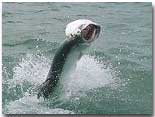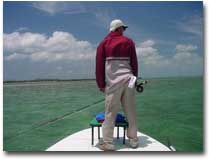Fishing for tarpon on fly in the Florida Keys
Fishing for tarpon on fly in the Florida Keys
 You're entranced by the crystal clear bluish green water and you find your mind
drifting. You notice how the color is reflected in the small clouds above
you. It's been fifteen minutes since the last string of tarpon has passed
the skiff. The skiff rocks gently as the guide shifts his weight. Suddenly,
you're back at ground zero. After the last attempt at the fish, you're
looking for a rock to crawl under. Your casting stroke looks as though
you're directing a fusion jazz band. You think of another use for that
rock. Perhaps throwing it at the fish. In an attempt to help relieve
the buck fever ailment, your guide calmly calls out the next school. "'Here
comes another good school. Eleven thirty, two hundred feet, seventy fish
or more." “Relax, you've plenty of time.“ You try and remain calm, but
you feel as if you're fifteen again and asking the hottest girt in school
to the prom. You're sweating, and you fear the guide might see your
legs and arms quivering. "Get ready!" "Aim for the tail of the lead fish."
"Go!" You start your backcast. In your grip, the twelve weight rod
feels heavy and cumbersome.
You wish you had taken the guide's advice after last years trip and put
a few minutes practice in each week. You make the presentation and thank
God it's in the strike zone. "Strip, Ssstttrriippp!" "Here he comes!" "Wait
for him to turn!". You watch as the seventy five pound fish rushes forward
and inhales your fly. As the offering disappears into the cavernous mouth,
you cautiously wait for him to turn back to the school before the hook
is set. Here it is, the moment of truth. Will you set the hook properly
and be prepared for the series of violent head shakes and successive leaps
from the water?
You're entranced by the crystal clear bluish green water and you find your mind
drifting. You notice how the color is reflected in the small clouds above
you. It's been fifteen minutes since the last string of tarpon has passed
the skiff. The skiff rocks gently as the guide shifts his weight. Suddenly,
you're back at ground zero. After the last attempt at the fish, you're
looking for a rock to crawl under. Your casting stroke looks as though
you're directing a fusion jazz band. You think of another use for that
rock. Perhaps throwing it at the fish. In an attempt to help relieve
the buck fever ailment, your guide calmly calls out the next school. "'Here
comes another good school. Eleven thirty, two hundred feet, seventy fish
or more." “Relax, you've plenty of time.“ You try and remain calm, but
you feel as if you're fifteen again and asking the hottest girt in school
to the prom. You're sweating, and you fear the guide might see your
legs and arms quivering. "Get ready!" "Aim for the tail of the lead fish."
"Go!" You start your backcast. In your grip, the twelve weight rod
feels heavy and cumbersome.
You wish you had taken the guide's advice after last years trip and put
a few minutes practice in each week. You make the presentation and thank
God it's in the strike zone. "Strip, Ssstttrriippp!" "Here he comes!" "Wait
for him to turn!". You watch as the seventy five pound fish rushes forward
and inhales your fly. As the offering disappears into the cavernous mouth,
you cautiously wait for him to turn back to the school before the hook
is set. Here it is, the moment of truth. Will you set the hook properly
and be prepared for the series of violent head shakes and successive leaps
from the water?
 The moment
passes and the leader holds. He's already two hundred feet out. Once again
the silvery giant detaches himself from the water. It happens
so slowly, the moment is etched. Just as you remember your first love,
you'll recall that jump for life. The mind drifts briefly and you're suddenly
reminded of watching Walker’s Cay television on Saturday morning. Only
in this segment, you're the star. Forty five minutes have passed, you feel
this fish will never succumb. Your arms are aching, your shirt is soaked
with perspiration. With words of encouragement and a few hints on
fighting a fish from old salty on the stern, the fish is soon alongside
the boat. The fish is leadered and the fly removed. Back to the dock for
that celebratory rum drink. The moment
passes and the leader holds. He's already two hundred feet out. Once again
the silvery giant detaches himself from the water. It happens
so slowly, the moment is etched. Just as you remember your first love,
you'll recall that jump for life. The mind drifts briefly and you're suddenly
reminded of watching Walker’s Cay television on Saturday morning. Only
in this segment, you're the star. Forty five minutes have passed, you feel
this fish will never succumb. Your arms are aching, your shirt is soaked
with perspiration. With words of encouragement and a few hints on
fighting a fish from old salty on the stern, the fish is soon alongside
the boat. The fish is leadered and the fly removed. Back to the dock for
that celebratory rum drink.
 Starting
in late April and ending in early July, these large migratory fish take
residence in the Florida Keys. Megalops Atlanticus (even the Latin
name sounds huge) average thirty pounds for a small fish, while a large
one averages 120 and may exceed 180 pounds. Fly tackle needs are ten to
twelve weight rods for the larger fish although a nine weight will land
a 40 pound or smaller fish. Weight forward floating lines are most commonly
used, however there are times a clear intermediate sinking line is necessary.
Casting ability is everything. The ability to shoot line with a minimum
of false casting, quickly and accurately at some distance will have a major
impact on your success or lack thereof. At forty feet, the fish sense the
boat or perhaps it’s that strange convulsing object on the bow. Having
an eighty foot cast will allow the tarpon to track a fly longer or give
an angler the ability to re-cast to another fish in the school before detection
by the fish. Of course there’s always the ever-present wind. That might make that eighty foot
cast a forty foot one. Pity the fly caster who can barely make thirty feet.
The temperature in the Florida Keys can best be described as hot and soupy
during the summer months. Cool, light colored cotton clothing, a large
brim hat and plenty of sunscreen are your best defense against the
intense sun. There are a wide range of accommodations available. From five
star hotels to a “mom and pop” with lots of charm, you’ll find one
to suit your budget and needs. Restaurants are many. Lots of locally caught
seafood dishes such as Stone Crab, Florida Lobster, Mahi-Mahi and Yellowtail
Snapper are caught daily. Getting here is fairly simple, Two hours south
from Miami International or north from Key West International airport.
One road, friendly natives and a great place to relax. It’s a very casual
place. No jacket or tie required. Book your trip early, the best
guides are booked up to a year in advance. Starting
in late April and ending in early July, these large migratory fish take
residence in the Florida Keys. Megalops Atlanticus (even the Latin
name sounds huge) average thirty pounds for a small fish, while a large
one averages 120 and may exceed 180 pounds. Fly tackle needs are ten to
twelve weight rods for the larger fish although a nine weight will land
a 40 pound or smaller fish. Weight forward floating lines are most commonly
used, however there are times a clear intermediate sinking line is necessary.
Casting ability is everything. The ability to shoot line with a minimum
of false casting, quickly and accurately at some distance will have a major
impact on your success or lack thereof. At forty feet, the fish sense the
boat or perhaps it’s that strange convulsing object on the bow. Having
an eighty foot cast will allow the tarpon to track a fly longer or give
an angler the ability to re-cast to another fish in the school before detection
by the fish. Of course there’s always the ever-present wind. That might make that eighty foot
cast a forty foot one. Pity the fly caster who can barely make thirty feet.
The temperature in the Florida Keys can best be described as hot and soupy
during the summer months. Cool, light colored cotton clothing, a large
brim hat and plenty of sunscreen are your best defense against the
intense sun. There are a wide range of accommodations available. From five
star hotels to a “mom and pop” with lots of charm, you’ll find one
to suit your budget and needs. Restaurants are many. Lots of locally caught
seafood dishes such as Stone Crab, Florida Lobster, Mahi-Mahi and Yellowtail
Snapper are caught daily. Getting here is fairly simple, Two hours south
from Miami International or north from Key West International airport.
One road, friendly natives and a great place to relax. It’s a very casual
place. No jacket or tie required. Book your trip early, the best
guides are booked up to a year in advance.
Visit Barry Hoffman at http://www.flatsguide.com
Capt. Barry Hoffman
|
